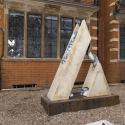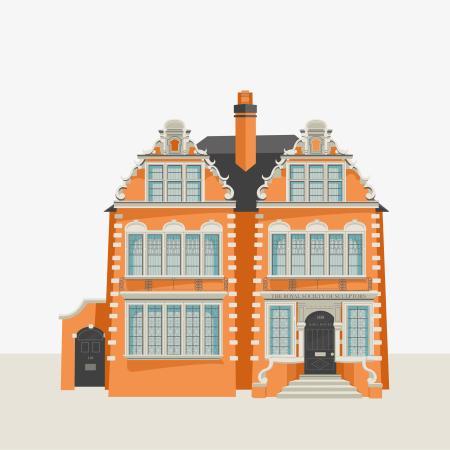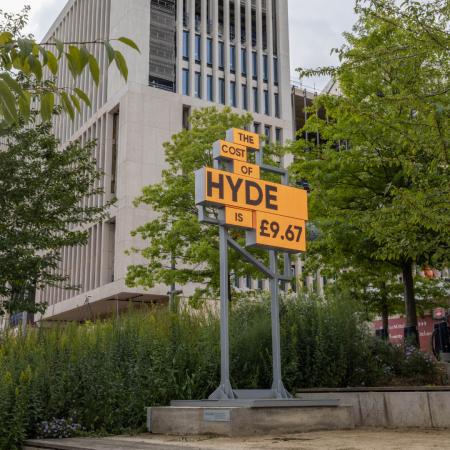Open! Channel! Flow! by Polly Morgan was unveiled on 27 February 2023 on the sculpture terrace accompanied inside by Morgan's False Flags exhibition with Leena Similu.
Click here for the full press release.
For further information, images, interviews and early access please contact Laura Callendar, E: laura@lauracallendar.com T: +44 (0) 7939 049731
The Royal Society of Sculptors unveils British artist Polly Morgan’s first public sculpture, Open! Channel! Flow on 27 Feb 2023. Winner of the Society’s First Plinth: Public Art Award, Morgan’s sculpture - her largest to date - will be on shown on the sculpture terrace at the newly restored Dora House from 27 February to 29 April, before being sited at the Queen Elizabeth Olympic Park.
Running concurrently, False Flags is Morgan’s joint exhibition with US artist Leena Similu. Here camouflage, mimicry and subterfuge are the inspiration for a series of painted snakeskin-textured sculptures, photographs and ceramic-based sculptural works which explore the politicisation of bodily adornments, drawing parallels between military and cultural warfare.
Open! Channel! Flow!
Taking its title from the name given to any conduit with a free surface, Open! Channel! Flow! consists of two triangles of furrowed concrete adorned with painted, iridescent fibreglass casts of snakes that spill from the crevices and connect the two. Through the use of materials commonly used in boatbuilding and nail decoration, Morgan uses modern technology to mimic nature at its most dazzling and obfuscatory.
The snakes are moulded into their concrete trenches, with their scales reflecting light as rainbows. The sculpture represents how we are all shaped and constrained by our environment: the refracted light is the energy, ebb and flow of ideas, and the serpentine forms embody all life; at points intertwining, repelling and jostling for position.
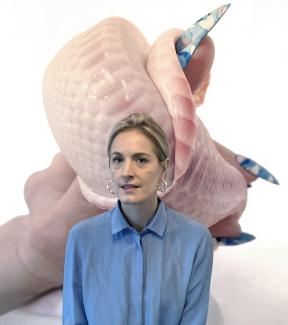
False Flags
You enter the gallery and see a pile of paper on the desk ahead. Press releases, like sails to steer the good ship in a favourable direction, contain strings of recherché adjectives, unearthed to overawe the reader into quiet submission. Look in this direction, please. And if you can’t understand us, then we must be smarter than you. Their claim to elucidate is a masked attempt to dominate.
Maybe this is the only honest press release you’ll ever read. Or perhaps it’s a double bluff - hoping to sway hardened cynics and jaded gallery-goers by flattering them into a sense of collusion. Are we laughing with you, or at you?
The practice in naval warfare of raising a neutral or enemy flag to misrepresent your identity or intent is a good example of the powerplay between predator and prey, with camouflage, mimicry and subterfuge being used to misdirect the opponent.
Similarly, the flare of a cobra’s hood to reveal large eyes more akin to those of a mammal, while displaying the colourful markings common to benign snakes, are all visual tricks employed by the deadly cobra to hide its true identity. It’s the oldest form of appropriation and, if detected, would mean cancellation of the severest kind.
Polly Morgan is white, with bitten, unpainted fingernails. Is it appropriate she uses in her work the sharp painted nails more commonly associated with black culture or good grooming? Her snake-textured augmented sprues, spine-like columns on which acrylic nails are packaged before application, are like strings of bunting or serried shields, beauty both as cue and armour. Beside these, her photographs of birds’ skins on serpentine wire look remarkably like the wigs worn by showmen, judges, and chieftains.
Leena Similu
Leena Similu makes anthropomorphic ceramics inspired by the masks of her mother’s homeland, Cameroon. Features exaggerated and expressions frozen, they sport shocks of human hair and wear earrings that resemble their younger selves had they lived.
The artists have been friends for decades and now, living in different continents, keep in touch online. Similu digs deep on Instagram, often sending Morgan videos of people who are avatar-like in their pursuit of beauty and favoured by the algorithm. Their faces, like emojis, have been distilled down to clear bright features in a coloured frame. Like Similu’s ritual masks, maybe these painted, sculpted faces will bring the wearers likes and long lives.
The story is the same as ever. Only this time, the Emperor is wearing gluteal implants, a feathered headdress and false nails. Or is he?
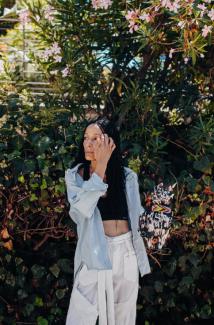
Exhibitions: Polly Morgan, Open! Channel! Flow! | Polly Morgan & Leena Similu, False Flags
Dates: 27 February - 29 April 2023
Address: Royal Society of Sculptors, Dora House, 108 Old Brompton Road, London SW7 3RA
Opening Times: Monday to Friday, 11am - 5pm www.sculptors.org.uk
For further information, images, interviews and early access please contact:
Laura Callendar, E: laura@lauracallendar.com T: +44 (0) 7939 049731
Polly Morgan (b.1980) is a British artist living and working in London. She is self-taught with no formal education in art and rose to attention after learning taxidermy in 2004 when she began to dismantle taxidermy traditions, creating unsettling still lives where the animal was observed in death rather than life. Recent works, making use of her model-making and painting skills, are illusory sculptures that combine taxidermy with cast objects and painted trompe l’oeil veneers and lie somewhere between figuration and abstraction.
Her work has been shown internationally and belongs in many notable collections including the Zabludowicz Collection, Thomas Olbricht, David Roberts Art Foundation and The New Art Gallery Walsall. She was chosen to represent Britain in Women to Watch 2015 at the National Museum of Women in the Arts, Washington and her work Departures was featured in the Thames and Hudson book 100 Works of Art that will Define our Age.
Leena Similu’s ceramic-based sculptural work is the result of an artistic examination of motherhood and heritage. Recent solo exhibitions include Keepers at Emma Gray HQ (Los Angeles), and group shows include Juggernaut at The Pit (Los Angeles). Similu has also presented works at Frieze LA and NADA. She is the Founder of Les Chiffoniers and the former Vice President, Design, Equipment; Head Designer Womenswear, Jil Sander and Design Director Womenswear, Stella McCarthy. The artist lives and works in Los Angeles.
About The Royal Society of Sculptors
The Royal Society of Sculptors is an artist-led, membership organisation. We support and connect sculptors throughout their careers and lead the conversation about sculpture today through exhibitions and events for all. Created more than 100 years ago to champion contemporary sculpture and the artists who create it, the Society welcomes everyone interested in exploring this art form and its many possibilities.
The Society was established in 1905 with 51 members, including all the leading sculptors of the day. The founder members were Sir Thomas Brock RA (President), Sir Charles Lawes-Wittewronge (Treasurer), Sir George Frampton RA, William Silver Firth, Frank Lynn Jenkins, Thomas Stirling Lee, David McGill, Sir William Reynolds-Stephens and Francis Derwent Wood RA. The aims of the Society were cited as, “The promotion and advancement in the United Kingdom of Great Britain and Ireland, and its Colonies and Dependencies, of the art of sculpture and the maintenance and protection of the interests of Sculptors and the elevation of the status of the Profession of Sculpture.”
In recognition of the Society’s services to the art of sculpture, it was granted royal patronage in 1911 and became the Royal Society of British Sculptors.
About the Sculpture Terrace
Situated at Dora House, 108 Old Brompton Road, the Society is an iconic building said to be the oldest building in the Royal Borough. It was originally built by William Blake in 1820 as a pair of early Georgian semi-detached villas. Its unique polychromatic frontage, influenced by the seventeenth century Dutch style of architecture, was added to its early Georgian core in 1886. The building was donated to the Society in 1976 by the sculptor Cecil Thomas. A place where the creative congregate, it has been a home - and studio space - to photographers, sculptors, architects, painters and designers for over 120 years.
Thomas was responsible for the careful restoration of the front elevation. He set up the Dora Charitable Trust, named after his wife who died in 1967, to protect the long-term future of the house and to fulfill the family’s generous intention to make the house and studio available to the Royal Society of British Sculptors, as it was then called, as it had had no permanent headquarters since its foundation in 1905. The Society has called Dora House home ever since.
